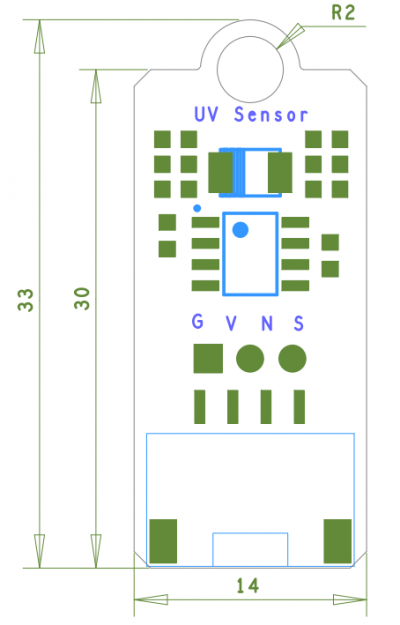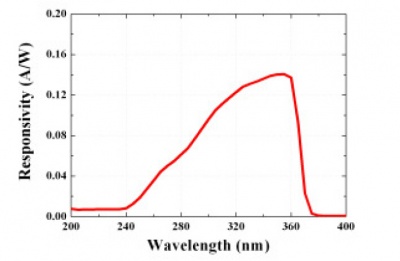Difference between revisions of "UV Sensor Brick"
(Created page with "==Overview== right What is an electronic brick? An electronic brick is an electronic module which can be assembled like Lego bricks s...") |
m (→Overview) |
||
| (One intermediate revision by the same user not shown) | |||
| Line 7: | Line 7: | ||
The UV Sensor is used for detecting the intensity of incident ultraviolet(UV) radiation. This form of electromagnetic radiation has shorter wavelengths than visible radiation. The UV Sensor is based on the sensor GUVA-S12D which has a wide spectral range of 200nm-400nm. The module outputs electrical signal which varies with the UV intensity, which gives your suggestion if it is a good idea to beach today. | The UV Sensor is used for detecting the intensity of incident ultraviolet(UV) radiation. This form of electromagnetic radiation has shorter wavelengths than visible radiation. The UV Sensor is based on the sensor GUVA-S12D which has a wide spectral range of 200nm-400nm. The module outputs electrical signal which varies with the UV intensity, which gives your suggestion if it is a good idea to beach today. | ||
| − | Go shopping [http://imall.iteadstudio.com/im150521005.html | + | Go shopping [http://imall.iteadstudio.com/im150521005.html UV Sensor Brick (IM150521005)] |
==Features== | ==Features== | ||
| Line 85: | Line 85: | ||
==Download== | ==Download== | ||
| − | [[:File:IM150521004-Electronic Brick - UV Sensor Brick- | + | [[:File:IM150521004-Electronic Brick - UV Sensor Brick-schematic.pdf]] |
| − | [[:File:IM150521004-Electronic Brick - UV Sensor Brick-dimension. | + | [[:File:IM150521004-Electronic Brick - UV Sensor Brick-dimension.pdf]] |
| − | + | ||
| − | + | ||
| − | + | ||
| − | + | ||
==Useful Links== | ==Useful Links== | ||
Latest revision as of 06:03, 15 July 2015
Contents
Overview
What is an electronic brick? An electronic brick is an electronic module which can be assembled like Lego bricks simply by plugging in and pulling out. Compared to traditional universal boards and circuit modules assembled with various electronic components, electronic brick has standardized interfaces, plug and play, simplifying construction of prototype circuit on one’s own. There are many types of electronic bricks, and we provide more than twenty types with different functions including buttons, sensors, Bluetooth modules, etc, whose functions cover from sensor to motor drive, from Ethernet to wireless communication via Bluetooth, and so on. We will continue to add more types to meet the various needs of different projects.
The UV Sensor is used for detecting the intensity of incident ultraviolet(UV) radiation. This form of electromagnetic radiation has shorter wavelengths than visible radiation. The UV Sensor is based on the sensor GUVA-S12D which has a wide spectral range of 200nm-400nm. The module outputs electrical signal which varies with the UV intensity, which gives your suggestion if it is a good idea to beach today.
Go shopping UV Sensor Brick (IM150521005)
Features
- High stability
- Good Sensitivity
- Low power consumption
- Schottky type photodiode sensor
- Wide response range
- Grove Interface
Specifications
| PCB size | 33.0mm X 14.00mm X 1.6mm |
| Power supply | 3.3 or 5V DC |
| Compatible interfaces | 2.54 3-pin interface and 4-pin Grove interface* |
Note:S for analog output port, V and G for voltage at the common collector and ground respectively
Electrical Characteristics
| Parameter | Min. | Typical | Max. | Unit |
| Operating voltage | 3.0 | 5 | 5.5 | VDC |
| Current | - | 0.3 | - | mA |
| Output voltage | 0 | - | VCC | VDC |
| Response wavelength | 200 | - | 370 | nm |
Hardware
Usage
UV sensors are used in many different applications. Examples include pharmaceuticals, automobiles, and robotics. UV sensors are also used in the printing industry for solvent handling and dyeing processes. In addition, UV sensors are also used in the chemical industry for the production, storage, and transportation of chemicals. The fact of the UV sensor work is: In sunlight, the UV index and Photocurrent are a linear relationship.
About our UV Sensor, we have converted Photocurrent to corresponding voltage value collected by Arduino/Iteaduino. The output voltage and the UV index is linear: illumination intensity = 307 * Vsig where: Vsig is the value of voltage measured from the SIG pin of the Grove interface, unit V. illumination intensity unit: mW/m2 for the combination strength of UV light with wavelength range: 240nm~370nm Note: To calculate the UV index value, please refer to http://www2.epa.gov/sunwise/uv-index. It's hard to say that the measurement from this sensor can be converted to the EPA standard UV index, but can be estimated roughly. UV Index = illumination intensity / 200
Demo
Connect it to A0 port of Iteaduino UNO. The demo code as show below.
void setup()
{
Serial.begin(9600);
}
void loop()
{
int sensorValue;
long sum=0;
for(int i=0;i<1024;i++)
{
sensorValue=analogRead(A0);
sum=sensorValue+sum;
delay(2);
}
sum = sum >> 10;
Serial.print("The voltage value:");
Serial.print(sum*4980.0/1023.0);
Serial.println("mV");
delay(20);
Serial.print("\n");
}
Download
File:IM150521004-Electronic Brick - UV Sensor Brick-schematic.pdf
File:IM150521004-Electronic Brick - UV Sensor Brick-dimension.pdf
 Notice
Notice

